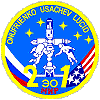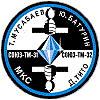Biographies of International Astronauts
![]()
HaigneréClaudieFrance |
 |
more photos |
![]()
Personal data
| Birthdate: | 13.05.1957 |
| Birthplace: | Le Creusot, Burgundy |
| Marital status: | married |
| Children: | one |
| Selection date: | 09.09.1985 |
| Selection group: | CNES-2 / EAC |
| Position: | Research Cosmonaut (RC) / Test Cosmonaut (TC) / LS |
| Status: | Ret. 18.06.2002 |
Spaceflights
| No. | Mission | Position | Time | Duration |
| 1 | Soyuz TM-24 / Soyuz TM-23 | Research Cosmonaut | 17.08. - 02.09.1996 | 15d 18h 23m |
| 2 | Soyuz TM-33 / Soyuz TM-32 | Flight Engineer | 21.10. - 31.10.2001 | 9d 19h 59m |
| 3 | ||||
| 4 | ||||
| 5 | ||||
| 6 | ||||
| 7 | ||||
| Total | 25d 14h 22m | |||
 |
 |
 |
 |
Backup assignments
| No. | Mission | Position |
| 1 | Soyuz TM-17 | Research Cosmonaut |
| 2 | Soyuz TM-29 | Flight Engineer |
Additional information
|
Education: Doctor of medicine (rheumatology).
Graduated from Faculté de Médecine (Paris-Cochin) and
Faculté des Sciences (Paris-VII). Certificates (CES Certificats
d’Etudes Spécialisées) in biology and sports medicine
(1981), aviation and space medicine (1982) and rheumatology (1984). In 1986
diploma (DEA Diplôme d’Etudes Approfondies) in biomechanics and
physiology of movement. From 1984 to 1992, Claudie Haigneré worked in the Rheumatology Clinic and the Rehabilitation Department and Sport Traumatology at Cochin Hospital in Paris. From 1985 to 1990, she also worked in the Neurosensory Physiology Laboratory at the Centre National de la Recherche Scientifique (CNRS) in Paris. Her research topics were human adaptation of motor and cognitive systems in weightlessness. Claudie Haigneré was selected as a French candidate astronaut in 1985 by France’s CNES space agency. From 1990 to 1992, she was responsible for French and international space physiology and medicine programmes in the CNES Life Sciences Division in Paris. From 1989 to 1992, she was responsible for scientific coordination of the life sciences experiments aboard 1992 Franco–Russian Antarès mission. She regularly took part in parabolic flight campaigns aboard the Zero-G Caravelle. In October 1992, Claudie Haigneré was assigned as back-up cosmonaut to Jean-Pierre Haigneré for the Franco–Russian Altair mission of July 01-22, 1993. During this mission, she was responsible for monitoring the biomedical experiments from the Mission Control Centre in Kaliningrad, near Moscow. From September 1993, Claudie Haigneré was responsible for coordinating the scientific programme of the Franco–Russian Cassiopée mission and for the French experiments aboard ESA’s EuroMir-94 mission. In December 1994, she was assigned to the Cassiopée mission as Research Cosmonaut and started training in Star City near Moscow on January 01, 1995. The 16-day mission took place from August 17, to September 02, 1996. In 1997, she worked in Moscow as the French representative of Starsem, the Franco–Russian company. In May 1998, Claudie Haigneré was selected as back-up for Jean-Pierre Haigneré for the Franco–Russian Perseus mission to Mir in February 1999. She trained for EVA and qualified as Cosmonaut Engineer for both the Soyuz vehicle and the Mir space station. During the mission, she was crew interface coordinator at the Mission Control Centre in Korolyev. In July 1999, she became the first woman to qualify as a Soyuz Return Commander, so that she could now command a three-person Soyuz capsule during an emergency return from space. On November 01, 1999, Claudie Haigneré joined the European Astronaut Corps, whose home base is the European Astronaut Centre (EAC) in Cologne, Germany. She took part in ESA development projects for the European Microgravity Facilities for Columbus and supported the medical activities in the Agency’s Directorate of Manned Spaceflight and Microgravity. In January 2001, she took up training in Star City near Moscow for her assignment for the Andromède mission. In March 2001, she was qualified by ESA/EAC for ISS Basic Training. From June 2002 to April 2004, Claudie Haigneré was appointed to the post of Minister for Research and New Technologies by the French Prime Minister. From April 2004 to June 2005, she served in the French Government as Minister for European Affairs and Secretary General for Franco–German Cooperation. From November 2005 to September 2009 she was Senior Adviser to ESA’s Director General in European space policy, and ESA’s strategic adaptation . From October 2009 to February 2015 she was the CEO of Universcience a French science museum that combined the Cité des Sciences and the Palais de la Découverte in Paris. She is part of the innovation jury (Concours Mondial de l’innovation) and chaired the scientific council of the chair du Collège des Bernardins (2014-2016) in Paris: Digital humanism. From February 2015, she returned to ESA as an adviser to the Director General. Claudie Haigneré enjoys contemporary art (painting, sculpture), reading and sport, especially gymnastics and golf. At the time of her first mission Soyuz TM-24 her name was "Claudie André-Deshays". |
Personal patches
 |
 |
| © |  |
Last update on April 23, 2021.  |
 |